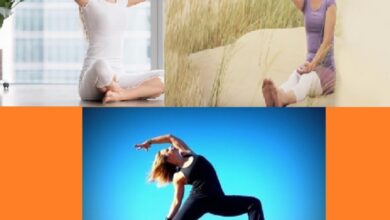
Yoga for eyesight is important to improve Vision. The number of visually impaired people of all ages worldwide is estimated to be around 285 million, with the bulk of them due to refractive errors problems (43 %) and cataracts (33 %).
According to a statistic published by the American Academy of Ophthalmology, by 2050, nearly 49.8% of the world’s population will have myopia.
With such troubling figures, it is impossible to dismiss the importance of regular vision care as part of one’s daily routine. Even just 10-15 minutes of yoga for eyes exercises every day will maintain ones eyes healthy and free of issues.
These yoga eye exercises for better eyesight will provide you with a variety of benefits, including improved vision, increased attention, and spiritual understanding. Yoga for eyes will aid in the protection of the vision.
Yoga For Eyesight: Eye Exercises To Improve Eyesight
Yoga for eyes exercise help to relax human eyesight and facilitate proper eye function when people perform them on a regular basis.
It is generally a good idea to splash their eyes with cold water a few times before beginning these exercises. Throughout the exercises, remember to maintain both head and spine straight.
1-Palming
- Relax by sitting quietly with ones eyes closed and taking a few deep breaths.
- Rub both palms together vigorously until they are warm, then gently place them over the eyelids.
- Feel the warmth of the palms of hands transfer to both eyes and eye muscles. People will feel instantly at ease.
- Close eyes and slowly lower both hands to feel the dryness fade away.
- Rub the palms once more and continue the process at least three times.
2-Blinking
- Sit comfortably and open your eyes.
- Blink around ten times quickly.
- Close your eyes for 20 seconds and relax while focusing on your breathing.
- Repeat this exercise five times more.
3-Side-Ways Viewing
- Sit with both legs straight out in front of oneself.
- Raise both arms with ones fists closed and thumbs facing upward.
- Look straight front of you at a position that is level with your eyes.
- Maintain this fixed position with your head and focus on the following one after the other by changing your eyesight to:
- The area between the brows
- Thumb on the left
- The area between the brows
- Thumb on the right
- The area between the brows
- Thumb on the left
- Rep this exercise 10–20 times more.
- Close your eyes and relax after doing this exercise.
Observe The Following Breathing Pattern As You Perform The Above Exercise:
- Inhale slowly and steadily in a neutral stance.
- Take a deep breath and turn your head to the side.
- Return to the center with an inhale.
4-Front And Sideways Viewing
- Sit with your legs straight out in front of you.
- Close your left hand and place it on your left knee with the thumb pointing upwards.
- Look straight front of you at a position that is level with your eyes.
- Maintain this position with your head.
- Focus your attention on the left thumb as you exhale.
- Inhale deeply and concentrate your gaze on a place in front of you that is level with your eyes.
- Then do the same thing with your right thumb.
- Rest by closing your eyes.
5-Rotational Viewing
- Sit with both legs straight out in front of you.
- Put your left hand on your left knee.
- With the thumb pointed upwards, raise the right fist above the right knee. Maintain a straight elbow.
- Focus your eyes on the thumb while maintaining your head motionless.
- With the thumb, make a circle while maintaining the elbow straight.
- In a clockwise and anti-clockwise manner, repeat this exercise five times each.
- Replace the right thumb and repeat the operation.
- Rest by closing your eyes.
Observe The Following Breathing Pattern During This Exercise:
- Inhale as you complete the circle’s upper arc.
- Exhale as you finish the lower arc.
6-Up And Down Viewing
- Sit with your legs straight out in front of you.
- Place both fists on the knees with both thumbs facing upwards.
- Raise the right thumb slowly while keeping the arms straight. With your eyes, follow the upward motion of the thumb.
- Gradually lower the thumb to the initial position after it has been lifted to the maximum. Maintain eye contact with the thumb while keeping the head motionless.
- Then do the same thing with your left thumb.
- Each thumb should be practiced five times.
- Throughout the process, keep your head and spine straight.
- Relax by closing your eyes.
Observe The Following Breathing Pattern As You Perform The Above Exercise:
- Raise your eyes and take a deep breath.
- Exhale and close your eyes.
7-Preliminary Nose Tip Gazing
- In a cross-legged position, sit.
- Raise your right arm straight in front of your nose.
- Keep your thumb pointed upward when making a fist with your right hand.
- Concentrate both of your eyes on the tip of your thumb.
- Bend the arm and move the thumb to the tip of the nose, keeping the gaze on the tip of the thumb throughout.
- Take this position with the thumb at the tip of the nose and the eyes fixed there for a time.
- Straighten the arm while constantly looking at the tip of the thumb.
- This is the end of a single round.
- Make at least five of these rounds.
Observe The Following Breathing Pattern As You Perform The Above Exercise:
- Inhale deeply while pulling the thumb to the tip of the nose.
- Keep your thumb on the tip of your nose and stay within.
- Exhale as you straighten your arm.
8-Near And Distant Viewing
- Standing or sitting near an open window with a clear view of the horizon is a good idea. Keep your arms close to your sides.
- For 5-10 seconds, concentrate on the tip of your nose.
- Rep this process 10-20 times more.
- Close your eyes and relax them.
Observe The Following Breathing Pattern:
- During close inspection, take a deep breath and inhale.
- During distant looking, exhale.
Our Verdict
Relax in Savasana for a few minutes after finishing all of the preceding exercises. Breathe naturally and gently, and don’t fight any ideas or feelings.
These eye yoga movements are supposed to help control blood pressure and improve the function of the optic nerves. Even basic eye workouts like fast blinking can restore the twinkle in your eyes, warding off the drudgery produced by long periods of exposure to electronic devices, and making them healthier and stronger.
Conclusion
More research is needed to back up the several claims made regarding eye yoga. There’s reason to suppose that eye yoga and other eye exercises can assist with eye strain by reducing tension and enhancing attention, but the truth is that there isn’t much scientific evidence to back this up.
If you want to attempt eye yoga, there’s very little risk, no requirement for fitness, and at worst, you’ll waste a minute or two of your time.
If you’re worried about your vision, dry eye, cataracts, or frequent eye strain, talk to your doctor. Eye yoga and other eye exercises are not a suitable substitute for medical advice from an eye doctor.
People May Ask
How To Improve Eyesight Naturally?
It is suggested that you eat eye-healthy nutrients (antioxidants and vitamin A) in the proper method. A good night’s sleep, regular eye yoga (palming, blinking, side-ways seeing, and so on), and breathing exercises (brahmari pranayama-humble bee breath) are all natural techniques to improve eyesight.
How Can I Cure My Poor Eyesight?
Myopia and hypermetropia can be treated with yogic practices. Palming, blinking, and other exercises can help to strengthen your weak eye muscles. Increase your vision by using corrective glasses after checking with a specialist.
Is Yoga Bad For Eye Pressure?
Yoga for eyes helps to lower blood pressure and improve the function of the optic nerves. Eye relaxation can be achieved by simple exercises such as quick blinking.
How Can I Improve Blurred Vision?
Eye lubrication, increased air quality, vitamin A supplementation, tension relaxation, and the use of corrective eyeglasses in conjunction with yoga for eyes and asanas for eyesight can all help with blurred vision.



